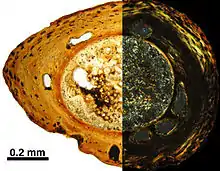Marmorerpeton
Marmorerpeton is an extinct genus of prehistoric stem group-salamanders that lived in Britain during the Bathonian stage of the Middle Jurassic.[1] They are among the oldest known salamanders.[2] Two species were named when the genus was first described by Susan E. Evans et al. in 1988, M. freemani, and M. kermacki, from fragmentary remains found via screenwashing in the Forest Marble Formation of England.[1] Due to the size of their osteocytic lacunae suggesting a large genome size and some morphological characters, like the presence of calcified cartilage in the medulla of its humerus, it was assumed that Marmorerpeton was neotenic.[3][4] New more complete remains of a new species M. wakei were described in 2022 from the Kilmaluag Formation of the Isle of Skye, Scotland. These conclusively demonstrated that Marmorerpeton was neotenic, and was a member of the family Karauridae, with the other two members of the family, Karaurus and Kokartus being known from the Middle-Late Jurassic of Central Asia.[5] The teeth appear to have been weakly pedicellate.[1]

| Marmorerpeton Temporal range: Middle Jurassic, | |
|---|---|
| Scientific classification | |
| Domain: | Eukaryota |
| Kingdom: | Animalia |
| Phylum: | Chordata |
| Class: | Amphibia |
| Family: | †Karauridae |
| Genus: | †Marmorerpeton Evans et al. 1988 |
| Type species | |
| †Marmorerpeton freemani Evans et al. 1988 | |
| Species | |
| |
References
- Evans, S. E.; Milner, A. R.; Mussett, F. (1988). "The earliest known salamanders (Amphibia, Caudata): a record from the Middle Jurassic of England". Geobios. 21 (5): 539–552. doi:10.1016/s0016-6995(88)80069-x.
- Marjanovic, D.; Laurin, M. (2014). "An updated paleontological timetree of lissamphibians, with comments on the anatomy of Jurassic crown-group salamanders (Urodela)". Historical Biology. 26 (4): 535–550. doi:10.1080/08912963.2013.797972. S2CID 84581331.
- Laurin, M.; Canoville, A.; Struble, M.; Organ, C.; de Buffrénil, V. (2015). "Early genome size increase in urodeles". Comptes Rendus Palevol. 15 (1–2): 74–82. doi:10.1016/j.crpv.2014.12.006.
- de Buffrénil, V.; Canoville, A.; Evans, S. E.; Laurin, M. (2015). "Histological study of karaurids, the oldest known (stem) urodeles". Historical Biology. 27 (1): 109–114. doi:10.1080/08912963.2013.869800. S2CID 83557507.
- Jones, Marc E. H.; Benson, Roger B. J.; Skutschas, Pavel; Hill, Lucy; Panciroli, Elsa; Schmitt, Armin D.; Walsh, Stig A.; Evans, Susan E. (11 July 2022). "Middle Jurassic fossils document an early stage in salamander evolution". Proceedings of the National Academy of Sciences. 119 (30). doi:10.1073/pnas.2114100119. ISSN 0027-8424.